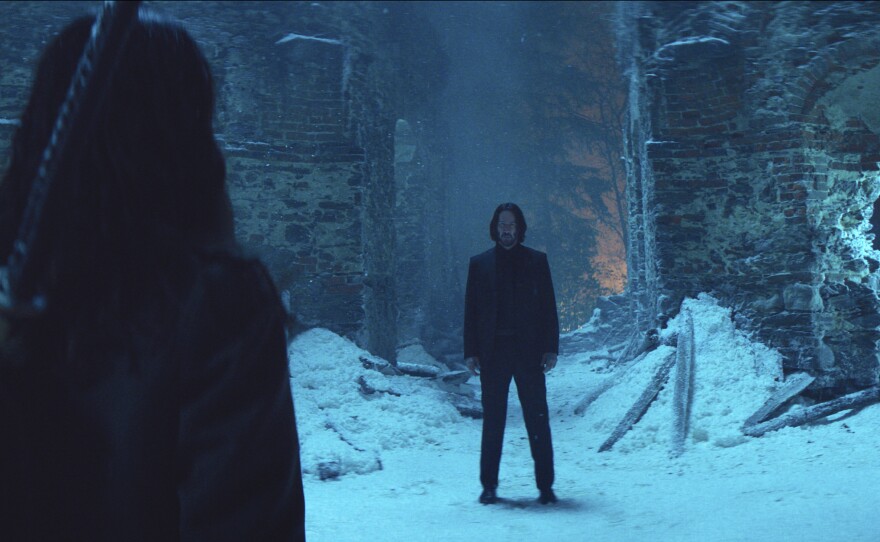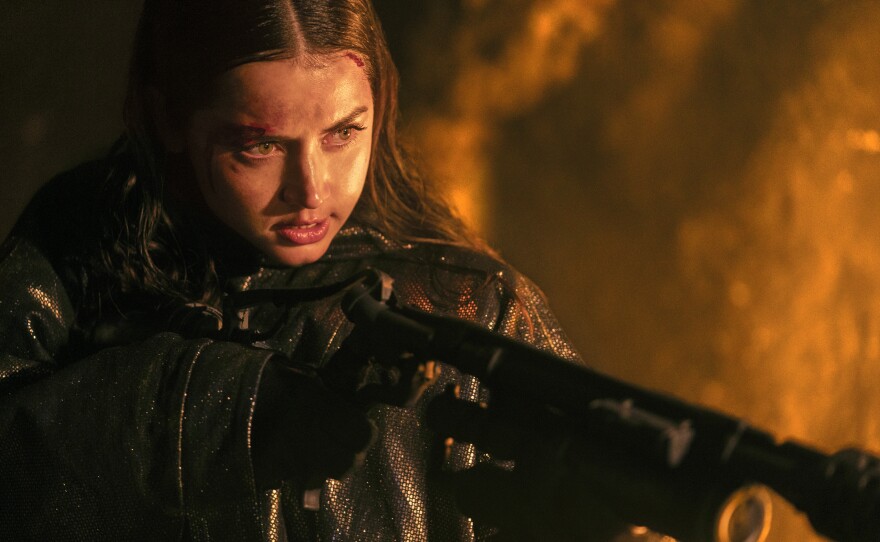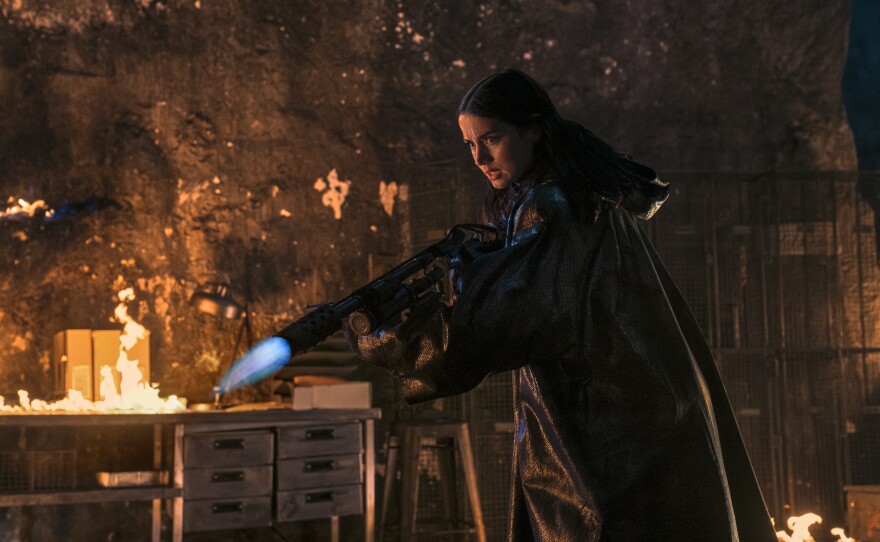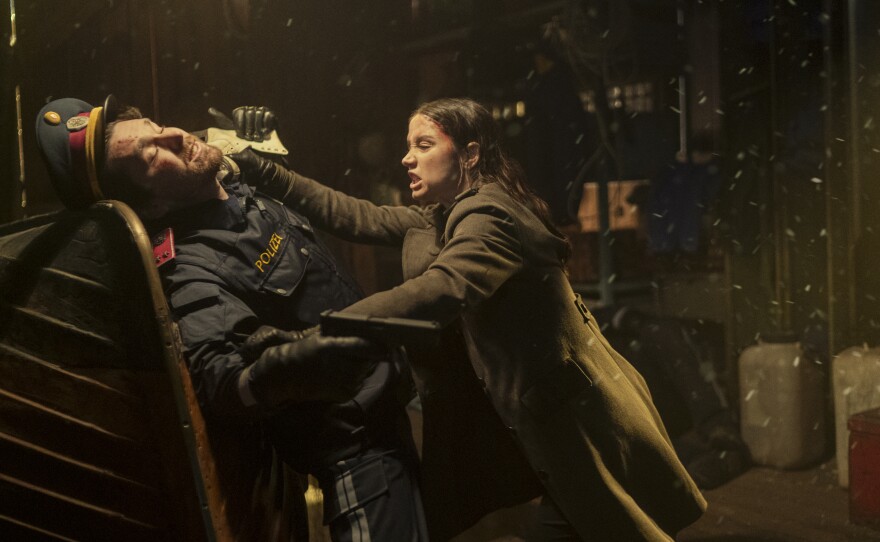Although John Wick has seemingly returned from the dead before, “Chapter 4” seemed to put a nail in that franchise’s coffin. That meant Lionsgate and producer/director Chad Stahelski had to come up with a creative way to keep the Wick franchise alive when its titular character was dead. The solution: Stories “From the World of John Wick,” starting with the disappointing series “The Continental,” and now the action-packed theatrical film “Ballerina.” In addition, there is a new documentary out about the franchise called “Wick is Pain.”
As an action film junkie, let me just say this up front — “Ballerina” 100% delivers kick-ass action and is a worthy entry into the Wick universe. So A+ on the action, but more like a C+ on everything else. Would I go see it in a cinema again? Absolutely. Action films are like musicals (only better). If the music and the choreography are great in a musical, then you can put up with some less-than-stellar storytelling. The action in "Ballerina" gave me a lovely action high, and I applaud that.
“Ballerina” traveled a rocky road to the screen. It began principal photography in 2022, was set to release in 2024, had disastrous preview screenings, went through what has been described as extensive reshoots and re-editing, and finally hit theaters this week. The resulting film does not look like a Frankenstein’s monster patchwork. It serves up a very formulaic story with jaw-dropping action that will make your adrenaline flow.

The basic idea of “Ballerina” is: what if we got the backstory to one of those ballerinas we see in the background of “John Wick 3: Parabellum” at the Ruska Roma run by Anjelica Huston’s The Director. “Ballerina” is meant to take place during the timeframe of “John Wick 3” and maybe a little into “John Wick 4.” That means Wick is alive, and it is not a spoiler to say that Keanu Reeves makes an appearance. Although, if you do the math, I am not entirely sure he had time and was healed enough to make this appearance. But don’t do the math — just enjoy getting a few more action moments with the Baba Yaga.
“Ballerina” opens with Eve (Victoria Comte) witnessing the death of her father at the hands of a mysterious cult led by The Chancellor (Gabriel Byrne). Orphaned, she (now played by Ana de Armas) ends up at the Ruska Roma, where she trains to be both a dancer and a lethal killer. For some reason — maybe because studios still think audiences cannot sympathize with a ruthless female assassin — Eve is presented as a “protector” (tapping into that maternal vibe, I guess) who is initially given rubber bullets. She is also instructed to “fight like a girl” in order to inspire her.

The film tries to make “fight like a girl” some kind of mantra (even providing a song for it), like reclaiming an insult and turning it into a battle cry. I have to say that it feels like the faux feminism of “Barbie.” After being told to fight like a girl, she kicks a male opponent in the groin. That’s not fighting like a girl. That’s just smart, and John Wick would do the same. It would have made more sense for the instructor to tell her: 'You’re a ballerina, you are faster and more nimble, use that!' Eve doesn’t need to fight like a girl; she just needs to be allowed to fight like a ruthless killer using real bullets and anything handy within arm’s reach.
Eventually, the film cuts her loose on a revenge rampage, and that’s when the film gets good and finds its action heart. It even delivers an action pas de deux involving flamethrowers, which I think is a first.

Although director Len Wiseman comes from the “Underworld” universe of handheld and fast-cut action, Chad Stahelski (stuntman-turned-director for all the “John Wick” films) has made sure that the elegant but breathtaking fight style of the “Wick” films carries over to “Ballerina.”
Action nerd break!
OK, I want to nerd out a little on how Stahelski raised the bar on American action. Stahelski worked on “The Matrix” movies and smartly learned from veteran Hong Kong stuntman and director Yuen Woo-Ping how to make action wildly kinetic and exciting on screen. It was about both learning to choreograph a fight tailored to a location and its props (which means a willingness to improvise or change at the last minute and not being rigidly committed to a plan), and then filming in a manner that lets the action truly sing on screen (which means fewer cuts and steady, long takes inspired by the work of the silent clowns of Hollywood and dancers like Gene Kelly). In every Wick film so far, Stahelski has included a quick clip or Easter egg paying tribute to silent film comedians like Buster Keaton. In “Ballerina,” you get a quick glimpse of Keaton on TV as Eve hits a thug with a remote, and the channels keep flipping until we land on Keaton in “Steamboat Bill, Jr.” In a way, the clip is a double tribute since the Keaton stunt we see also inspired Jackie Chan, another key influence on Stahelski’s stunt work and cinematic approach to action. I would also suggest that a fight with plates feels a little like a riff on a Mack Sennett pie fight. But maybe that’s just me.
Stahelski understands that by letting action play out in longer takes or steadier shots, we can appreciate how much work goes into the action sequence and how good the people are doing the work. If you have to make an edit on every punch, then your actor or stunt guy is not very good or the director lacks confidence in them.
Since I am not a huge fan of Wiseman's work, I am thinking that Stahelski may have come in and raised the bar on the action in "Ballerina."

De Armas is no Keanu Reeves — that's not a surprise. But points for trying to reach such a high bar. She is serviceable as an action star, but lacks a flair for action. The best action is action that reveals something of the personality of the character. Jackie Chan wins us over by charming us with his humanity and vulnerability. Reeves gives Wick a sort of laidback Zen style of action: do the minimum to kill your opponent, don't waste time. But de Armas is mostly just stoic and determined.
De Armas might have been cast as Eve based on her impressive work as a Bond girl in “No Time to Die.” But the reason she was so good was that her character was presented to us as kind of silly and unskilled, so when she suddenly unleashed lethal violence, we were surprised and impressed. But now that she is presented as a deadly serious assassin, there is no longer an element of surprise, and we have to buy for the entire length of the movie that she can fight like John Wick. And when the film casually serves up Jung Doo-hong (of the South Korean action epic "City of Violence") as an opponent, it's hard to accept that she can even last one round with him.
De Armas works hard and she never detracts from the action, but she doesn’t bring any style or personality to it — just a kind of somber resolve. Charlize Theron in “Atomic Blonde” had more flair and was more convincing in the action.
“Ballerina” will definitely provide a satisfying action fix. I just wish the script had been better crafted to create a more original female action character and to find something a little fresher to explore in the Wick universe. But being ranked as the lowest film in the John Wick universe still puts it head and shoulders above almost everything else Hollywood is putting out.
'Wick is Pain'
But for action junkies, there is also the documentary “Wick is Pain” (currently streaming on multiple platforms) about the making of the four “John Wick” movies. It provides a lot of behind-the-scenes footage, as well as interviews with the key players — Reeves, Stahelski, “John Wick” co-director David Leitch, producers Basil Iwanyk and Erica Lee. The documentary gives us an insider’s view of the films, the challenge of pulling off the first one when financial backing fell through at the last minute, the physical challenges of the stunts, and the insane dedication of Reeves and Stahelski to upping the ante with each film in the franchise.

The only real shortcoming of the documentary is that it never asks Stahelski about the influence of silent film comedians — people he calls the first stuntmen — and never asks him to really delve into his cinematic style.

But we do see how smart both Stahelski and Leitch — who created the action design company 8711 — were in creating a new kind of action cinema, first as stuntmen and second-unit directors, and then as film directors themselves. Their overview of stunts as being about constant training, choreography, visual approach and innovation is impressive. There is one particularly insightful moment when Leitch is describing a fight designed for a Jason Statham film called “Safe.” The stunt team did a “pre-viz” (or pre-visualization, where action is visually planned and outlined before filming begins) that, even in its rough stage, was breathtakingly exciting and fresh. But Statham rejected the action sequence, though bits of the “gun-fu” action made it into the film. Leitch expresses bafflement that the choreography wasn’t immediately embraced, and as we watch the footage, it does look spectacular. But we get to see the snippet of the gun-fu that ended up in “Safe,” and it completely rejects the steady camera and long takes for a very mediocre fast-cut, shaky-cam approach to the action. Highlighting the contrast between the approaches reveals what innovators Leitch and Stahelski have been for American action films. But American action films still have a long way to go to match the bonkers insanity of Asian action films at their best.
After watching “Wick is Pain,” I wanted to go re-watch the entire franchise with a new appreciation for all the blood, sweat and tears that went into those films. Stahelski and Reeves seem perfectly matched as a creative team, with each sort of competitively pressing the other to do better and go for more. I am not sure anyone else involved in the films had their fierce drive and passion, but they pulled together crews and actors who still signed up for the ride. And as an action junkie, I am forever grateful for the John Wick universe.










